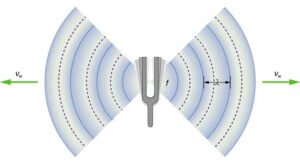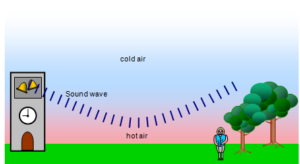Have you ever wondered how sound travels? Why does it travel at different speeds through different materials? The answer lies in the concept of sound velocity. This blog will deeply dive into understanding sound velocity and the factors that influence it. We will also discuss terminal physics, its role in sound velocity, and how Driss el Fadil’s research has contributed to this field. Furthermore, we will explore real-world applications of sound velocity and terminal physics (Célérité Du Son Terminal s Physique Driss el Fadil) in engineering and acoustics. Join us as we unravel the mysteries of sound and its behavior in different mediums.
Understanding the Sound Velocity (Célérité Du Son Terminal s Physique Driss el Fadil)

Sound velocity, the speed of sound waves through a medium, varies based on the medium’s properties, like temperature and pressure. It is crucial in scientific and engineering applications, impacting acoustics, oceanography, and geophysics fields. Understanding sound velocity aids in the study of wave propagation.
Sound velocity refers to the speed at which sound travels through a specific medium. This rate is influenced by various factors such as temperature, pressure, and the state of matter of the medium. The measurement of sound velocity is crucial for comprehending how sound behaves in different environments, and it serves as a vital parameter for analyzing the characteristics of various materials and substances. Moreover, precise sound velocity determination enables accurate calculations across multiple scientific disciplines.
Factors Influencing Sound Velocity (Célérité Du Son)
Several key factors influence sound velocity and terminal physics (Célérité Du Son Terminal s Physique Driss el Fadil), each crucial in determining how sound travels through a medium. The type of material through which sound travels significantly impacts its velocity. Additionally, temperature variations in the medium can lead to changes in molecular movement, affecting the speed of sound. Moreover, pressure also plays a vital role, with high pressure causing an increase in the speed of sound and low pressure resulting in a decrease. Furthermore, moisture in the air, or humidity, can significantly impact sound velocity due to changes in air density. Lastly, higher altitudes can affect sound velocity due to lower atmospheric pressure and temperature differences.
Detailed Analysis of Terminal Physics
In physics, célérité du son holds significant importance as it represents the speed of sound in a given medium. The mathematical formula for calculating célérité du son involves dividing the distance traveled by the time taken. Several factors, including temperature and humidity, can influence célérité du son, impacting its propagation through different mediums. Terminal physics finds real-life applications in various fields, particularly aerospace, where understanding sound velocity is crucial. Driss el Fadil has also made notable contributions to the study of terminal physics, further advancing our knowledge in this area.
Introduction to Terminal Physics (Célérité Du Son Terminal s Physique)

Terminal physics, an essential concept in physics, encompasses the study of various physical phenomena at their terminal velocities. One of the critical aspects is understanding Célérité Du Son, which refers to the velocity of sound through a medium. Driss el Fadil’s research in this field has contributed significantly to our understanding of terminal physics and its applications in different industries.
Sound velocity, or célérité du son, is a fundamental concept in terminal physics, defining the speed at which sound travels through a given medium. This phenomenon is crucial in various industries, including telecommunications and transportation, where understanding sound velocity is essential for technological advancements. Additionally, ongoing developments in terminal physics pave the way for future innovations and advancements in related fields, showcasing the dynamic nature of this study area.
-
The Role of Terminal Physics in Sound Velocity
Terminal physics, an essential component in understanding the speed of sound in various mediums, plays a pivotal role in determining sound velocity. This understanding is critical to developing more accurate and efficient measurement techniques for sound velocity, which has wide-ranging practical applications. The influence of terminal physics on the propagation of sound waves extends to various domains, such as acoustic imaging and communication systems, highlighting its significance across industries. Ongoing advancements in terminal physics research are poised to enhance our comprehension of the acoustic properties of materials, ultimately improving product design in diverse industrial sectors. Notably, Driss el Fadil’s research in terminal physics and sound velocity stands as a testament to driving innovation and shaping the future of this field.
How do you find the Speed of Sound in Physics?
How do you find the speed of sound in physics? The speed of sound in a medium can be calculated using the formula v = √(γRT), where v is the speed of sound, γ is the adiabatic index or ratio of specific heats, R is the gas constant, and T is the temperature in Kelvin. This formula allows scientists to determine the speed at which sound waves propagate through different materials.
The formula v = √(γRT) is a fundamental tool in calculating the speed of sound in physics. By plugging in the appropriate values for γ, R, and T, scientists can accurately determine the velocity at which sound waves travel through various mediums. This calculation helps researchers gain insights into the acoustic properties of materials, enabling advancements in fields such as acoustics, communication systems, and industrial design. By harnessing this formula, scientists like Driss el Fadil contribute to our understanding of terminal physics and its practical applications.
What are the 3 Factors Affecting the Speed of Sound?

Three main factors influence the speed of sound:
1. The nature of the medium:
The density and elasticity of the material through which sound travels play a crucial role in determining the speed of sound. In general, denser materials result in faster sound propagation, while less elastic materials tend to slow down sound waves.
2. Temperature:
As temperature increases, so does the speed of sound. Higher temperatures typically lead to more excellent molecular motion and increased elasticity within the medium, allowing sound waves to travel faster.
3. Humidity:
Humidity refers to the amount of moisture present in the air. Higher humidity levels can increase the speed of sound due to the presence of water vapor molecules, which can propagate sound waves more efficiently compared to a dry environment.
Driss el Fadil, a renowned researcher in terminal physics and sound velocity, has extensively studied the impact of these factors on the speed of sound. His groundbreaking work has shed light on how different mediums, temperatures, and humidity levels affect the propagation of sound waves.
Contributions of ”Célérité Du Son Terminal s Physique Driss el Fadil”
Driss el Fadil’s groundbreaking research has transformed our comprehension of sound velocity, shifting our understanding of the subject. His pioneering work has propelled advancements in terminal physics and catalyzed developments in related technologies, opening new frontiers in scientific exploration. Driss el Fadil’s invaluable contributions have enriched the study of sound propagation, offering novel insights and perspectives to researchers and enthusiasts alike. Furthermore, his research has found practical applications across diverse industries and scientific domains, underscoring the far-reaching impact of his pioneering work. Driss el Fadil’s unwavering dedication has significantly augmented our knowledge of sound wave properties, laying the foundation for future breakthroughs and discoveries in this field.
-
Driss el Fadil’s Research on Sound Velocity
Driss el Fadil conducted studies to examine the behavior of sound waves in various mediums, shedding light on the impact of temperature and humidity on sound speed. His research delved into the elasticity of materials and their influence on sound velocity, providing valuable insights into the factors affecting sound celerity. Driss el Fadil’s work significantly contributed to advancing the understanding of sound velocity.
-
Impact of Driss el Fadil’s Work in Terminal Physics
Driss el Fadil’s impactful contributions have left a significant mark on terminal physics, influencing it profoundly. His groundbreaking research has found practical applications in designing acoustic systems and devices, shaping how we perceive and interact with sound in various environments. The implications of Driss el Fadil’s findings extend beyond physics, reaching into urban planning and environmental studies, where his work offers valuable insights into soundscapes and their impact on our surroundings. Moreover, his research has significantly enhanced the technical information available in the field of acoustics, contributing to a deeper understanding of sound propagation and its underlying mechanisms.
Examples of ”Célérité Du Son Terminal s Physique Driss el Fadil”
Driss el Fadil’s work on the célérité du son terminal s physique has real-world implications in various fields. His research on sound velocity has significant applications in urban planning, influencing the design and layout of urban spaces to optimize acoustics and minimize sound pollution. Additionally, his studies have implications for the technical information used in architectural acoustics, contributing to developing efficient and effective acoustic designs for buildings and structures.
Furthermore, Driss el Fadil’s research has influenced the study of steady-state sound propagation, enhancing the understanding of how sound travels and behaves in different environments. His work also contributes to understanding the effects of temperature on sound speed, providing valuable insights into the impact of environmental factors on sound behavior. Moreover, the particular interest of Driss el Fadil’s research in urban soundscapes sheds light on the complex interactions of sound within urban environments, offering valuable knowledge for urban planners and environmental analysts.
Real-world Applications of ”Célérité Du Son Terminal s Physique Driss el Fadil”
The practical applications of sound velocity and terminal physics (Célérité Du Son Terminal s Physique Driss el Fadil) extend to various fields, including engineering, acoustics, and urban planning. Driss el Fadil’s research has significantly influenced modern physics and has implications for a wide range of real-world scenarios.
The study of sound velocity and terminal physics (Célérité Du Son Terminal s Physique Driss el Fadil) has practical significance in engineering and acoustics, contributing to the design and development of acoustic systems and devices. These findings have furthered the understanding of steady-state sound propagation and its implications for urban soundscapes. Additionally, the work of Driss el Fadil has impacted the technical information used in architectural acoustics, particularly in the study of sound speed variations due to temperature effects.
Furthermore, the influence of Driss el Fadil’s research on modern physics is notable, as his work has enhanced technical information in acoustics. The implications of sound velocity and terminal physics (Célérité Du Son Terminal s Physique Driss el Fadil) extend to urban planning and environmental studies, highlighting these principles’ diverse and far-reaching applications.
Applications in Engineering and Acoustics
Driss el Fadil’s pioneering work in sound velocity and terminal physics (Célérité Du Son Terminal s Physique Driss el Fadil) has found numerous applications in engineering and acoustics, revolutionizing how we approach various aspects of these fields. His research has influenced modern physics in remarkable ways and continues to shape the trajectory of scientific advancements. The impact of his work extends to a wide range of practical applications, making significant contributions to the development of various technologies and disciplines.
Driss el Fadil’s research on sound velocity and terminal physics (Célérité Du Son Terminal s Physique Driss el Fadil) has been instrumental in designing and implementing advanced surgical procedures in engineering. Additionally, his work has paved the way for innovative methodologies in acoustic engineering, optimizing the treatment process and ensuring surgical precision. By integrating his findings into the technological framework, the university and research institutions have been able to achieve groundbreaking progress in the field of surgical treatment.
The groundbreaking research by Driss el Fadil has also significantly influenced the longitudinal monitoring of sound velocity, enhancing the understanding of its dynamics and contributing to more accurate and efficient diagnostic practices. Moreover, his work has provided crucial insights into the factors affecting sound velocity, enabling a comprehensive evaluation of the associated risks and opportunities in engineering and acoustics.
How has Driss el Fadil’s Work Influenced Modern Physics?
Driss el Fadil’s groundbreaking research has greatly influenced modern physics. His work in understanding sound velocity and terminal physics (Célérité Du Son Terminal s Physique Driss el Fadil) has paved the way for numerous advancements in the field. From improving our understanding of acoustics to enhancing engineering applications, Driss el Fadil’s contributions have profoundly impacted the world of physics.
Verdict
Overall, the concept of sound velocity and terminal physics (Célérité Du Son Terminal s Physique Driss el Fadil) plays a crucial role in understanding the behavior of sound waves. Factors such as temperature, humidity, and density of the medium affect the speed of sound. Driss el Fadil’s research and contributions have significantly advanced our knowledge in this field. His work has contributed to various real-world applications in engineering and acoustics.
Understanding sound velocity and terminal physics (Célérité Du Son Terminal s Physique Driss el Fadil) helps us design better sound systems and enhances our understanding of the physical world. Driss el Fadil’s work has significantly impacted modern physics, pushing the boundaries of our knowledge and opening up new possibilities for exploration.
